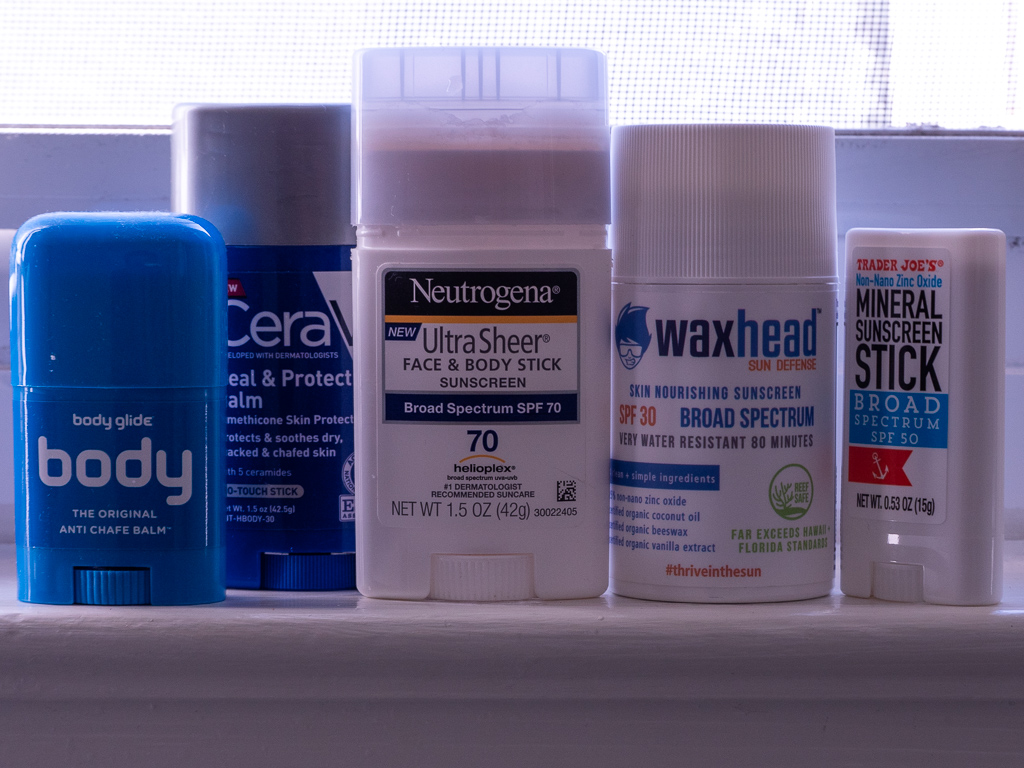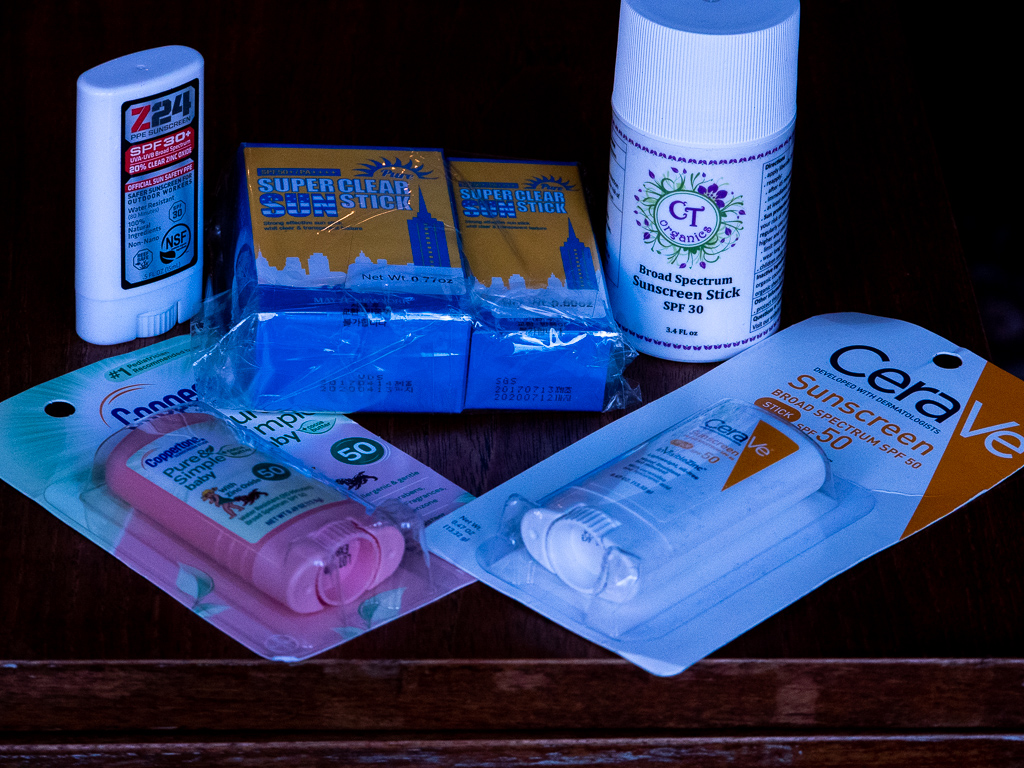
A hoax turns out to be true. Among the many apocryphal reports on the internet is the story that the late novelist Kurt Vonnegut (author of Slaughterhouse Five) delivered a commencement address at MIT in which he stated the “only one tip for the future” he offered was “wear sunscreen.” Alleged to have occurred in 1997, when the web remained a frontier, in fact the comic text was a newspaper column by the more obscure Mary Schmich. (A Pulitzer Prize winner, she subsequently published a book to promote the only semi-facetious suggestion.)
The endorsement of sunscreen is smart. Like run commuting, once you embrace it you want to tell others to do so. I am a convert to sunscreen. I share my own account of why, to explain how everyone ought to slather on protection against the very source of light and warmth that has enabled life on our planet. I also offer a description of various brands, having indulged in a half dozen of the more practical and less cosmetic for purposes of this analysis. I claim no expertise, and my testing was haphazard. The main point holds, whether from Vonnegut or Schmich or me: there is ample reason to wear sunscreen. Schmich had it right furthermore, that advice, like youth, is wasted on the young.
I should admonish myself. My wife had been reminding me and even scolding me, but my doctor was insistent: even on a run commute of an hour, without bright sun constantly shining, the cloud cover appearing to block the threat, sunscreen is needed. Regular readers may recall I was diagnosed a year and a half ago with a rare, serious autoimmune disorder. I had chemotherapy for pemphigus vulgaris, in the first cohort after approval of the infusion previously limited to lymphoma, and I am lucky to be in remission and striving to return to form as a run commuter. Extreme sun sensitivity is a lingering side-effect.
At my annual checkup, my primary care physician examined my red neck, made a face to express her disgust at my stupidity as well as skin, and said, “it looks fungal.” My severe burn, from running three half marathons over three weeks, had not only failed to heal but also become infected. Thus I am an outlier. Two prescription creams cured the problem, itchy and painful. The standing orders are sunscreen even if out for a drive in the car.
Everyone should take precautions though. The risk from sun exposure is real. A nephew, only slightly younger than me, was diagnosed with melanoma. He recently underwent surgery to have his nose rebuilt.
I went online. That is what we do. I am not alone in my enthusiasm. On social media, I am amazed you can watch videos of people trying every product they can purchase, recording the unboxing (sometimes only that experience, for popular gadgets) and everything else thereafter, in amateur reviews. Experts participate, too: more than one board-certified dermatologist chats about the subject, agreeing that sunscreen is vital to health and not merely appearance. There are people playing with brands: with and without makeup; in active scenarios, one side of the face coated in this and the other side of the face coated in that; children enlisted for experiments, and so on. Apparently Asian, specifically Korean, skin products have achieved popularity, gray market imports commanding premium prices.
Two basic categories of sunscreen exist. They are mineral and chemical. (A linguistically minded scientist would point out the division abuses “chemical,” because “mineral,” like anything material, means chemical.) The former, also called physical, uses one of two active agents, zinc oxide and titanium dioxide, to create a shield against the two types of ultraviolet rays and the visible spectrum. In many formulations, these leave a white tint on the surface, which has the advantage of showing what has been left bare. The latter soaks into the skin and absorbs the rays. It takes a moment to take effect, and labels instruct to apply in advance. “Broad spectrum” is preferable and the norm. A “reef safe” formula is urged for swimmers considerate of aquatic life.
“SPF” refers to protection from UVB rays; once above 30, the quantity rating isn’t that important, since the scale is not linear and nothing other than sitting in a dark room will block 100 percent of harmful light. What matters more than the brand is the quantity used, the quality of the coverage, and the frequency of reapplication. That is what the experts state, as born out by experience.
What is new are the sticks. This means the mutual massaging of sunscreen on the beach can be avoided, for those who always considered it creepy. My excuse for not taking up sunscreen earlier was the greasy or sticky, or both greasy and sticky, feeling of lotion, which smelled and felt dirty, especially over the course of the day. There now are alternatives that are smooth, dry, and not annoying. You don’t have to pour liquid onto your hands. (I have been using the backs of my hands, which likewise benefit from sunscreen, to rub into the face what has to be spread a bit.)
I limited my shopping to the sticks. I then ordered those that appeared to have the least objectionable list of ingredients. My estimate is that sticks constitute approximately a tenth of the total market of available sunscreens. They include the chemical and the mineral. I’m betting some of these sticks share an OEM and are rebadged, because they seem to be the same from the packaging to the contents. They are becoming a commodity.
Among the chemical options, I recommend the Neutrogena UltraSheer SPF 70. I do so because I found few appreciable differences among the choices. They all performed adequately or better. Some lasted longer, but there are too many variables (such as the rate of perspiration and weather conditions) to be confident there is a consistent distinction. A few felt more comfortable, in a subtle manner that also is no doubt highly personal. Neutrogena is a reliable manufacturer with pure content. The cost was surprisingly reasonable, on a per unit basis at the bottom — although I had deemed Neutrogena a luxury name, sunscreen runs into the exorbitant (in tiny bottles) so even what is costly relative to drugstore ointments is cheap relative to “beauty aids.” It is as silky as these come.
Among the mineral options, I recommend the Waxhead. The same criteria are satisfied. Waxhead, a boutique, claims to use a very few simple constituents for its line of merchandise (there is white and tinted with natural coloring). It also is expensive at first glance but economical upon calculation. I bought multiple tubes online to reduce the transaction costs. I gave one to my niece for her kids. Compared to the chemical rivals, the mineral varieties involve more work. Unless you like to have a pale cast (which surfers sport), you have to engage in some smearing. It is not too heavy.
My technique has been to apply two layers to ensure I have not missed a spot. I cover the ears and behind the ears, easy to overlook until you suffer damage there. I am susceptible not on the neck itself but where the neck begins/ends, which I am guessing is not idiosyncratic. For a run commute, that protocol is sufficient. For a half marathon, I have doubled up: chemical, then mineral. (I also assessed a combination of non sunscreen stick balm with non stick sunscreen, but that seemed redundant given that the stick sunscreen has emollient qualities.)
I’ll conclude that the decision, once you are persuaded to adopt sunscreen in daily ablutions (brush teeth, floss, comb hair, neti pot, shave — sunscreen), is chemical versus mineral. Then it is maintaining the regimen. That is similar to run commuting. It’s one thing to believe an activity would be beneficial; it’s another thing to cultivate the habit.
That is my summary. I advocate sunscreen.

I tried altogether the following stick sunscreens and stick balms (by category, in alphabetical order):
Chemical
- May New York Super Clear SPF 50
- Neutrogena Beach Defense SPF 50
- Neutrogena UltraSheer SPF 70
Mineral
- Babo Botanicals Super Shield Sport Stick SPF 50
- Cerave InvisibleZinc SPF 50
- Coppertone Pure & Simple Baby SPF 50
- CT Organics Sunscreen Stick SPF 30
- Goddess Garden Sport SPF 50
- Thinksport Sunscreen Stick SPF 30
- Trader Joe’s Mineral Sunscreen Stick SPF 50
- Waxhead Sun Defense SPF 30
- Z24 SPF 30
Non Sunscreen Stick Balms
- Body Glide Anti Chafe
- Burt’s Bee’s Hydrating Stick with Aloe Water
- Cerave Heal & Protect Stick
Non Stick Comparison
- Blue Lizard Australian Sunscreen SPF 30
- Supergoop Play Everyday Sunscreen
